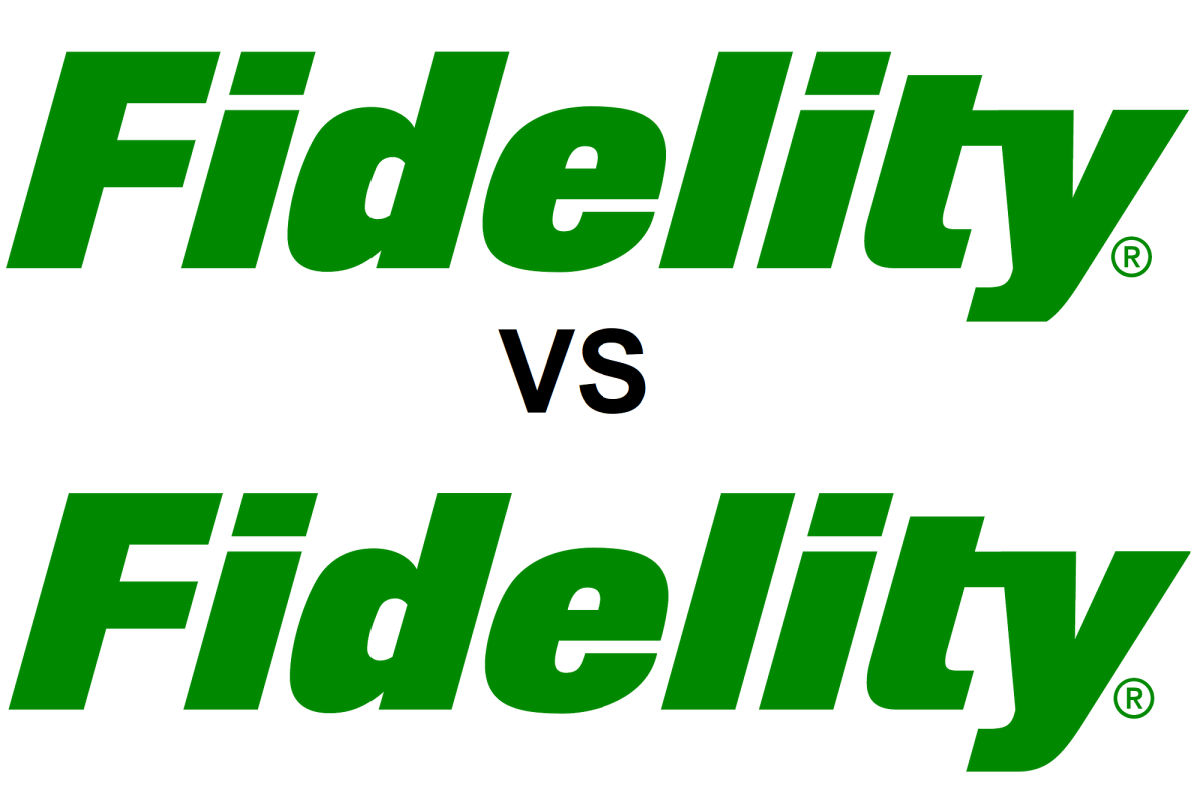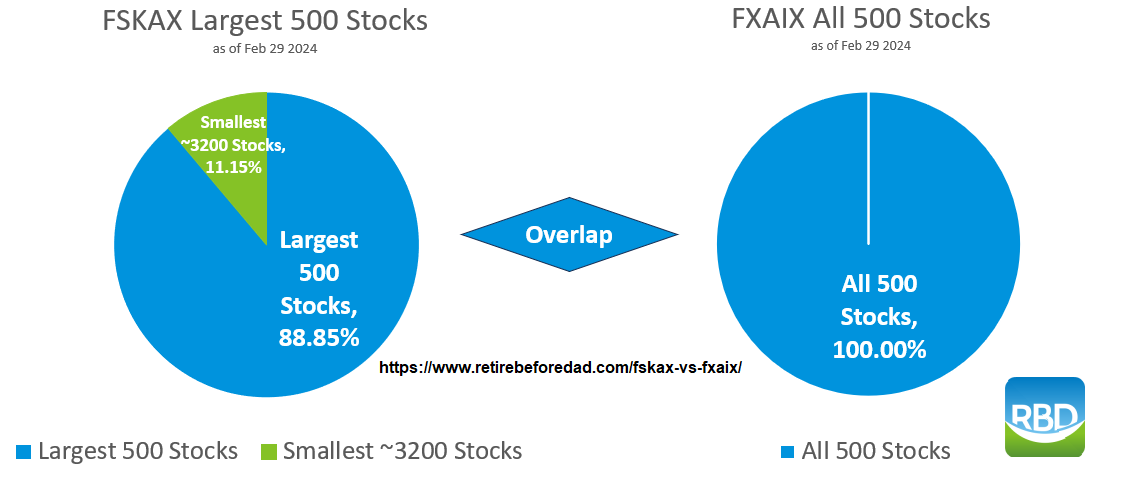FSKAX vs FXAIX: Comparing Fidelity’s Popular Index Funds
This page contains links to our partners. RBD may be compensated when a link is clicked. Read disclosures.
 This article compares FSKAX vs FXAIX — Fidelity’s Total Market Index Fund vs Fidelity’s S&P 500 Index Mutual Fund.
This article compares FSKAX vs FXAIX — Fidelity’s Total Market Index Fund vs Fidelity’s S&P 500 Index Mutual Fund.
Both are passively managed index mutual funds popular in retirement accounts for investors seeking near-market returns vs risk-free high-yield savings.
Index mutual funds track market indexes, such as the S&P 500.
FXAIX tracks the S&P 500, while VTSAX is much broader — tracking the total market of more than 3,700 U.S. stocks.
You own a tiny piece of the largest U.S. companies if you own either fund.
Passive index fund managers do not pick stocks. They allocate money to all stocks in the market index to track its performance and take a small fee to achieve this outcome.
Since most actively managed mutual funds do not beat their target benchmarks, many fiduciary financial planners recommend index funds instead of actively managed funds or individual stocks.
Table of Contents
Bottom Line Upfront (BLUF)
Before I get into the details of FSKAX vs FXAIX, it’s important to keep the following in mind:
- Both funds are excellent, low-fee options for your portfolio. Don’t overthink your choice.
- FSKAX has 7X more holdings, including the S&P 500 stocks plus mid-cap and small-cap stocks. But FXAIX has outperformed.
- The funds have almost 90% weighted overlap (see Overlap section).
- Investors who do not have a Fidelity account can invest in ETF equivalents (see Equivalents section).
Please note that both funds update their prospectuses regularly. The information referenced in this article will change over time.
Fidelity’s website is the best resource for both funds.
Here are links to the most updated information at Fidelity. Consider the information on those pages to be the authoritative data source.
FSKAX vs FXAIX — Side-by-Side Comparison
Here’s a side-by-side comparison of both funds. Scroll right on mobile.
A few noticeable differences comparing FSKAX vs FXAIX:
- The benchmark indexes are different.
- FXAIX is much larger from a net assets perspective. However, the FSKAX is still very large.
- Expense ratios are low and identical.
- FXAIX returns have outperformed FSKAX in the short, mid, and long term. This could be due to the 2023 performance of the Magnificent Seven stocks, including Nvidia.
FSKAX vs FXAIX — Overlap
As a market-cap-weighted index, the top 500 stocks in FSKAX make up a high percentage of the fund. FXAIX is also market-cap-weighted but has only 500 stocks.
Therefore, there is a significant overlap between the funds.
The top 500 stocks in FSKAX make up approximately 89% of the fund’s weighted holdings. The balance of stocks, about 3,200 small and mid-cap stocks, comprise the remaining 11% of the ETF’s weighted holdings.

FSKAX vs FXAIX — Benchmark Indexes
FSKAX is indexed to the Dow Jones US Total Stock Market Index.
S&P Global owns the Dow Jones U.S. Total Stock Market Index. Visit this page to find a Fact Sheet and Methodology documentation with the latest information on that page.
The index has more than 3,700 U.S. constituents.
FXAIX is indexed to the S&P 500 Market Index maintained by S&P Global. Visit this page for the latest information about the index.
The index also has about 500 constituents, comprising the largest companies traded in U.S. markets.
The two indexes overlap by almost 90% when accounting for weights.
FSKAX vs FXAIX Chart — Performance
Here’s a daily updated 10-year FSKAX vs FXAIX chart tracking against each other. Scroll right on mobile.
Due to their significant overlap, these funds perform mostly in unison. Therefore, either one is suitable for broad equity coverage in your portfolio.
See the table above for up-to-date three, five, and ten-year average annual performance records.
This chart updates daily and does not account for dividend distributions. Hover over the lines for prices.
FSKAX vs FXAIX — Top Ten Holdings
Here are the top ten holdings for each fund. For the most updated lists, visit the links at the beginning of the article.
FSKAX
| As of 04/03/2024 | |||
|---|---|---|---|
| # | Symbol | Company | Weight |
| 1 | MSFT | Microsoft Corp. | 0.0624 |
| 2 | AAPL | Apple Inc. | 0.05421 |
| 3 | NVDA | NVIDIA Corp. | 0.03768 |
| 4 | AMZN | Amazon.com Inc. | 0.03337 |
| 5 | META | Facebook Inc. Class A | 0.02208 |
| 6 | GOOGL | Alphabet Inc. Class A | 0.01663 |
| 7 | BRK-B | Berkshire Hathaway | 0.01478 |
| 8 | GOOG | Alphabet Inc. Class C | 0.0138 |
| 9 | LLY | Eli Lilly & Co. | 0.01307 |
| 10 | AVGO | Broadcom Inc. | 0.01172 |
FXAIX
| As of 04/02/2024 | |||
|---|---|---|---|
| # | Symbol | Company | Weight |
| 1 | MSFT | Microsoft Corp. | 0.0719 |
| 2 | AAPL | Apple Inc. | 0.0618 |
| 3 | NVDA | NVIDIA Corp. | 0.0457 |
| 4 | AMZN | Amazon.com Inc. | 0.03759 |
| 5 | META | Facebook Inc. Class A | 0.02544 |
| 6 | GOOGL | Alphabet Inc. Class A | 0.01916 |
| 7 | BRK-B | Berkshire Hathaway Inc. Class B | 0.01742 |
| 8 | GOOG | Alphabet Inc. Class C | 0.01628 |
| 9 | LLY | Eli Lilly & Co. | 0.01405 |
| 10 | AVGO | Broadcom Inc. | 0.01335 |
FSKAX vs FXAIX — Vanguard Equivalents
- The FSKAX Vanguard equivalent is VTSAX.
- The FXAIX Vanguard equivalent is VFIAX.
- The FSKAX Vanguard ETF equivalent is VTI.
- The FXAIX Vanguard ETF equivalent is VOO.
Exchange-traded funds (ETFs) trade like stocks. You can buy or sell them during the day on a stock exchange.
ETFs are easier to own, and the price changes throughout the day. Mutual funds only trade at the market close.
Active investors typically use ETFs for trading purposes or to buy and hold indexes when they can’t access index mutual funds.
For example, if you have an investing account with M1 Finance, you’d invest via ETFs instead of mutual funds. If your account is with Fidelity or Vanguard, you’d likely use the index funds FSKAX vs FXAIX.
Vanguard has an ETF called the Vanguard Total Stock Market Index ETF (symbol: VTI), equivalent to FSKAX. But it’s an ETF, not a mutual fund.
Therefore, you can buy VTI on a stock exchange from any online broker (here are my favorites).
I own VTI and recommend it often to people who are not with a large mutual fund company and want to own the total U.S. market.
Fidelity partners with iShares (owned by Blackrock) to offer its customers easy access to several passive index fund ETFs.
The FSKAX iShares equivalent is the iShares Core S&P Total U.S. Stock Market ETF(symbol: ITOT), which is a good ETF with a low expense ratio (about 0.03%). You can buy the ITOT through any online broker.
Use the above resources to find the most up-to-date information regarding VTI vs VOO vs ITOT.
Best Brokers to Own Index Funds and ETFs
What is the best broker for market index ETFs if not Fidelity or Vanguard?
Fidelity and Vanguard are excellent choices for long-term retirement investors. You’re in good hands if your IRA or employer-sponsored plan is with either broker.
I recommend another broker for those looking for a more modern user experience that can also serve your banking and spending needs.
Long-term investors may prefer an online broker that’s better for dollar cost averaging and dividend reinvestment.
I’m a big fan of the online brokerage M1 Finance. M1 Finance is a reliable and robust, no-fee online broker for beginner to intermediate investors. It’s easy to get started.
As your investing skills and portfolio mature, M1 is one of the best platforms to scale. They also offer an integrated checking account and low borrowing rates. Read my complete M1 Finance review here.
M1 Finance does not offer mutual funds (ETFs are available). But it’s my favorite for everyday investing.
The platform is more intuitive than old-school brokers because it’s built on a modern technology platform.
You create portfolio “pies” that contain all the stocks and ETFs you want to own and in what percentages. Simply add a total market ETF to a pie and add funds to your account.
Conclusion
Deciding between FSKAX vs FXAIX comes down to owning small, mid, and large-cap stocks vs large cap only.
Because of how the market indexes are weighted, the two funds are almost 90% identical. Either fund is suitable for your portfolio. FSKAX provides total market exposure, while FXAIX only holds the 500 largest U.S. stocks.
Those with a Fidelity account can own FSKAX or FXAIX. Consider ETF equivalents if you are with another broker.
Companies that become part of the S&P 500 are some of the most successful in the world. Annually, select stocks in this index outperform the rest of the market.
FXAIX is less diluted than FSKAX, and therefore, fast-growing stocks in the S&P 500 index have a greater influence on FXAIX’s performance than FSKAX’s, even though both funds hold the same companies.
ETFs will give you the same coverage, performance, and low cost at any commission-free online broker.
Please reply with your questions regarding FSKAX vs FXAIX in the comments section below. Include any requests you have about adding more detail to this article.
Additional Resources
Disclosure: The author owns FSKAX, FXAIX, and VTI. The opinions expressed are solely those of the authors and do not reflect the views of M1. They are for informational purposes only and are not a recommendation of an investment strategy or to buy or sell any security in any account. They are also not research reports and are not intended to serve as the basis for any investment decision. Prior to making any investment decision, you are encouraged to consult your personal investment, legal, and tax advisors.

Craig is a former IT professional who left his 19-year career to be a full-time finance writer. A DIY investor since 1995, he started Retire Before Dad in 2013 as a creative outlet to share his investment portfolios. Craig studied Finance at Michigan State University and lives in Northern Virginia with his wife and three children. Read more.
Favorite tools and investment services right now:
Sure Dividend — A reliable stock newsletter for DIY retirement investors. (review)
Fundrise — Simple real estate and venture capital investing for as little as $10. (review)
NewRetirement — Spreadsheets are insufficient. Get serious about planning for retirement. (review)
M1 Finance — A top online broker for long-term investors and dividend reinvestment. (review)
